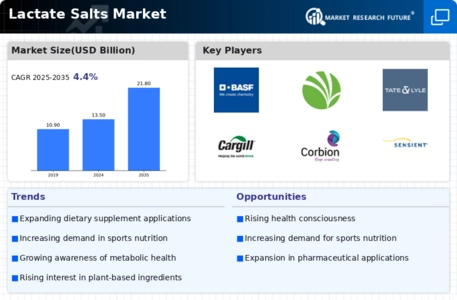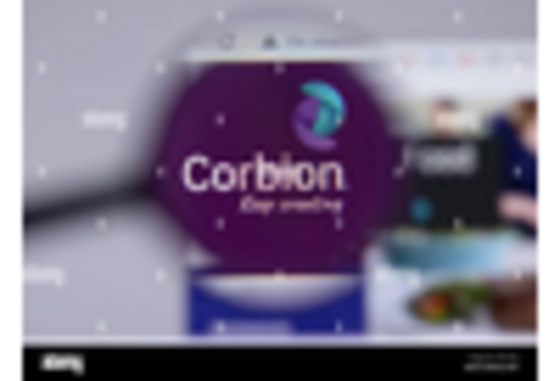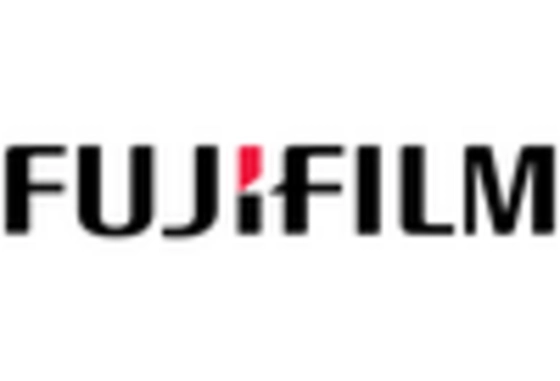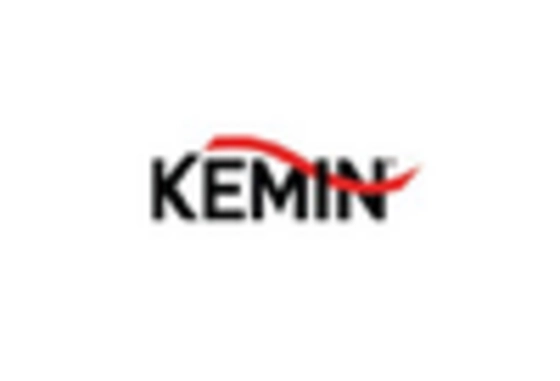Increasing Health Awareness
The Lactate Salts Market is experiencing a surge in demand driven by a growing awareness of health and wellness among consumers. As individuals become more conscious of their dietary choices, the preference for products that support physical performance and recovery has intensified. Lactate salts, known for their role in enhancing athletic performance and reducing muscle fatigue, are increasingly being incorporated into various nutritional supplements. This trend is reflected in market data, which indicates a steady growth rate of approximately 6% annually in the sports nutrition segment. The rising inclination towards healthier lifestyles is likely to propel the Lactate Salts Market further, as consumers seek effective solutions to optimize their physical capabilities.
Rising Popularity of Functional Foods
The Lactate Salts Market is witnessing a notable increase in the popularity of functional foods, which are designed to provide health benefits beyond basic nutrition. Consumers are increasingly seeking foods that can enhance their physical performance and overall well-being. Lactate salts, recognized for their ability to improve exercise performance and recovery, are being integrated into various functional food products. Market data indicates that the functional foods segment is projected to grow at a rate of 7% annually, reflecting a shift in consumer preferences towards products that offer added health benefits. This trend is likely to bolster the Lactate Salts Market as manufacturers innovate to meet the demands of health-conscious consumers.
Expansion of Sports and Fitness Industry
The Lactate Salts Market is poised for growth due to the expansion of the sports and fitness sector. With an increasing number of individuals participating in sports and fitness activities, the demand for performance-enhancing supplements, including lactate salts, is on the rise. Market analysis suggests that the fitness industry has seen a compound annual growth rate of around 8% in recent years, indicating a robust interest in health and fitness. This expansion is likely to create a favorable environment for lactate salts, as athletes and fitness enthusiasts seek products that can aid in endurance and recovery. Consequently, the Lactate Salts Market stands to benefit from this burgeoning sector.
Growing Demand for Vegan and Plant-Based Products
The Lactate Salts Market is experiencing a shift towards vegan and plant-based products, driven by changing consumer preferences and dietary choices. As more individuals adopt plant-based diets, the demand for lactate salts derived from natural sources is likely to increase. This trend aligns with the broader movement towards sustainability and ethical consumption, which is influencing purchasing decisions. Market Research Future indicate that the plant-based food sector is expanding at a rate of approximately 9% annually, suggesting a significant opportunity for lactate salts that cater to this demographic. Consequently, the Lactate Salts Market may see enhanced growth as it adapts to the rising demand for vegan-friendly options.
Technological Advancements in Product Development
The Lactate Salts Market is benefiting from technological advancements in product development, which are enhancing the efficacy and appeal of lactate salt formulations. Innovations in processing techniques and ingredient sourcing are enabling manufacturers to create more effective and palatable products. This is particularly relevant in the context of the sports nutrition market, where consumers are increasingly discerning about product quality and performance. Recent data suggests that companies investing in research and development are likely to capture a larger market share, as they introduce novel formulations that meet evolving consumer needs. As a result, the Lactate Salts Market is expected to thrive amid these technological advancements.


















Leave a Comment